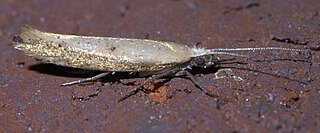
Apamea crenata, known as the clouded-bordered brindle, is a moth in the family Noctuidae. It is distributed throughout the Palearctic realm. In the North it crosses the Arctic Circle, in the Mediterranean it is found only in cool locations and mountains avoiding very hot areas. In the Alps, it rises to an altitude of about 2000 metres.

Plusia festucae is a species of moth of the family Noctuidae. It is found throughout the Palearctic realm from Ireland to Japan.

Cataclysta lemnata, the small china-mark, is a moth species of the family Crambidae. It is found in Europe, Morocco and Iran.

Ypsolopha scabrella, the wainscot hooktip or wainscot smudge, is a moth of the family Ypsolophidae. The species was first described by Carl Linnaeus in 1761. It is found in Europe, China, Russia, Asia Minor and mideast Asia.
Ypsolopha barberella is a moth of the family Ypsolophidae. It is known from the United States, including Arizona, Nevada and Utah.

Ypsolopha unicipunctella is a moth of the family Ypsolophidae. It is known from the United States, including Oklahoma, Texas and Arizona.
Ypsolopha oliviella is a moth of the family Ypsolophidae. It is known from the United States, including Arizona.
Ypsolopha arizonella is a moth of the family Ypsolophidae. It is known from the United States, including Arizona.
Ypsolopha schwarziella is a moth of the family Ypsolophidae. It is known from the United States, including Arizona, Utah and California.
Ypsolopha striatella is a moth of the family Ypsolophidae. It is known from the United States, including California.
Ypsolopha gerdanella is a moth of the family Ypsolophidae. It is known from the United States, including New Mexico.
Ypsolopha delicatella is a moth of the family Ypsolophidae. It is known from the United States, including Arizona and California.
Ypsolopha nella is a moth of the family Ypsolophidae. It is known from the United States, including Arizona and Utah.
Ypsolopha querciella is a moth of the family Ypsolophidae. It is known from the United States, including Arizona and Utah.
Ypsolopha walsinghamiella is a moth of the family Ypsolophidae. It is known from the United States, including Arizona and California.
Ypsolopha maculatella is a moth of the family Ypsolophidae. It is known from the United States, including Arizona and California.
Ypsolopha vintrella is a moth of the family Ypsolophidae. It is known from the United States, including Arizona and California.
Ypsolopha undulatella is a moth of the family Ypsolophidae. It is known from the United States, including Arizona, Utah and Colorado.
Ypsolopha buscki is a moth of the family Ypsolophidae. It is known from the United States, including Arizona.

Phalonidia lavana, or Platphalonidia lavana, is a species of moth of the family Tortricidae, the subfamily Tortricinae, and the tribe Cochylini. It has a terrestrial habitat and is found throughout North America. It does not have a Global Conservation Status Rank.





